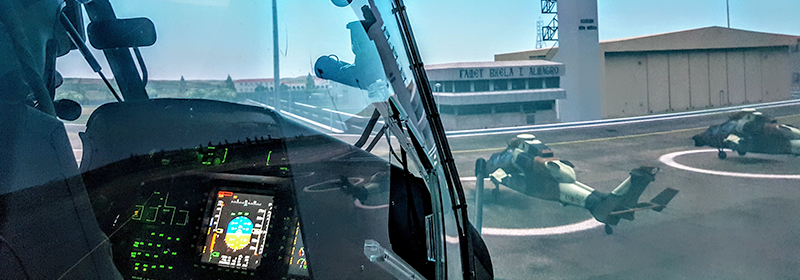- CESIHEL has eight simulators of different helicopter models connected to a network, allowing training in the most complex mission scenarios. It is a reference center in Europe with such a capacity to jointly train from different sites.
- It is the European leader in joint tactical training for helicopter crews, including the most advanced tactical capabilities in all types of scenarios and operating conditions, especially with night vision devices (NVG)
- The partnership between the Spanish Army and Indra allows us to maximize the use of the center where Armed Forces from around the world are trained, which also helps to reduce costs

The Helicopter Simulation Center (CESIHEL) is one of the backbones of the Aviation Academy of the Spanish Army (ACAVIET) where pilots and mechanics of the Spanish Army Air Force are trained. Developed with Indra, It is one of the most advanced simulation centers in Europe, especially in joint tactical training of crews.
The simulation center comprises flight simulators (FFS) and helicopter trainers for the CH-47D Chinook, AS532 Cougar, EC135 and EC665 Tiger, located at two different bases: Colmenar Viejo, with six simulators, and Almagro, where two simulators of the Tiger helicopter are located. All of them have been developed with Indra technology.
In 2019, two simulators of the new NH90 helicopter, also developed by Indra, will enter service at the Agoncillo Base. With this, the network of simulators connected for joint training will reach the milestone of ten devices.
CESIHEL is a leading center thanks to the combination of top-level instructors and extensive experience in international deployments operating in the most hostile environments, the excellence of the training programs for the different courses, ranging from the initial type certification in the helicopter to the most complex tactical training, and finally, the level of the simulator technology, especially in terms of their capacity to provide network operated joint training.
The ability to provide advance joint tactical training in a network, with different platforms and from different sites, makes of this center a reference in Europe. It also makes it possible to train in the most complex and high-risk missions, with a high degree of realism, in all kinds of scenarios, with multiple threats and in all types of weather conditions (the operations with night vision goggles, NVG, are one of the Center's specialties). CESIHEL has several scenarios, both in the national territory as well as areas of operation abroad, areas of importance for national defense (international deployments, possible conflict zones). These capabilities have been used to train crews prior to FAMET deployments, such as those conducted in Afghanistan.
Through a partnership agreement with the Army, Indra provides maintenance and improvement services for the simulators. In return, the Army allows the use of the facility, whenever available, for Indra to provide training services to other clients. Therefore, several Armed Forces perform their training at CESIHEL. Pilots from different country worldwide.
It is a magnificent example of public-private collaboration between Armed Forces and industry, and this collaboration increases the prestige of CESIHEL while significantly reducing costs for the Army.
About Indra
Indra is one of the leading global technology and consulting companies and the technological partner for core business operations of its customers world-wide. It is a world-leader in providing proprietary solutions in specific segments in Transport and Defence markets, and the leading firm in Digital Transformation Consultancy and Information Technologies in Spain and Latin America through its affiliate Minsait. Its business model is based on a comprehensive range of proprietary products, with a high-value focus and with a high innovation component. In the 2017 financial year, Indra achieved revenue of €3.011 billion, with 40,000 employees, a local presence in 46 countries and business operations in over 140 countries.